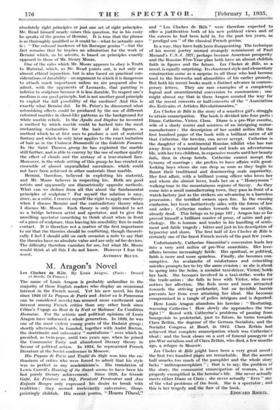Baroque and Modern
Henry Moore. By Herbert Read. (Zwernmer. 68.)
THERE are few contemporary English artists to whom it would be worth while devoting a monograph, but Mr. Henry Moore is certainly among them. His importance lies in the fact, hinted at by Mr. Read in his introductory essay, that Mr. Moore has brought English sculpture back on to a sane track after its deviations almost since mediaeval times. Mr. Moore is a sculptor of genius Mid also a man who worlth, apparently almost consciously, on sound principles, and it is the aim of Mr. Read to expound these principles in his essay. In doing this he discusses at great length the old distinction between carving and modelling which is now become a com- monplace of criticism, but he points out that Mr. Moore is not a pure carver in the sense in which an extremist like Mr. Stokes would use the phrase. He shows that Mr. Moore is concerned with interpreting his mental conceptions within the limits of a set of conventions established by his knowledge of the forms suitable to different materials. He does not, therefore, surrender himself to his material, but rather treats it with respect, at the same time remaining conscious of his superiority to it. Mr. Read is at pains to show that Mr. -Moore bases his work- ultimately on a careful study of the model and to distinguish him sharply from a sculptor like Braneusi, who expresses almost pure abstractions in solid form.
Mr. Moore therefore works in accordance with, and Mr. Read gives expression to, a set of consistent and interesting principles, But the question remains whether they are the
absolutely right principles or just .one set of right principles. Mr. Read himself nearly raises this question, for in his essay he speaks of the genius of Bernini. It is true that the phrase is as thoroughly qualified as it could be—what he actually says is : " The colossal insolence of his Baroque genius "—but the fact remains that he implies an admiration for the work of Bernini which, as he admits, is based on principles exactly opposed to those of Mr. Henry Moore. - One of the rules which Mr. Moore appears to obey is Truth to Material, which, as Mr. Read points out, is not only an almost ethical injunction, but is also based on practical con- siderations of durability— an argument to which it is dangerous to attach much importance unless we are prepared also to admit, with the opponents of Leonardo, that painting is inferior to sculpture because it is less durable. To respect one's medium is one good principle, but is not another good principle to exploit the full possibility of the medium? And this is exactly what Bernini did. In St. Peter's he discovered what astonishing effects could be produced by the use of different coloured marbles in cloud-like patterns as the background for white marble reliefs. In the' Apollo and Daphne he invented a method by which marble could be hacked into the most enchanting tortuosities for the hair of his figures, a Method which he at first uses to produce a sort of material fantasy and which he only later applies to the exact imitation of hair as in the Costanza Buonarelli or the Gabriele Fonseca. In the Saint Theresa group he has exploited the marble still further, and is able to convey_by the use of surface quality the effect of clouds and the ecstasy of a tear-stained face. Moreover, in the whole setting of this group he has created an ensemble of almost unparalleled succulence, which could not have been achieved in other materials than marble.
Bernini, therefore, believed in exploiting his material, and Mr. Moore believes in respecting his. Both are good artists and apparently use diametrically opposite methods. What can we deduce from all this- about the fundamental principles of sculpture ? For myself the solution is easy, since, as a critic, I reserve myself the right to apply one theory when I discuss Bernini and the contradictory theory when I discuss Mr. Moore. Each theory is only intended to act as a bridge between artist and spectator, and to give the unwilling spectator something to think about when in front of a piece of sculpture, thus leaving his sensibility free to make - contact. It is therefore not a matter of the first importance to me that the theories should be conflicting, though theoreti- cally I feel I should add on each occasion a note to say that the theories have no absolute value and are only ad hoc devices: The difficulty therefore vanishes for me, but what Mr. Moore would think at allthis I do not know. However I fear the















































 Previous page
Previous page